-1752474937173.webp)
Actress Olivia Munn recently revealed that her mother, Kim Munn, was diagnosed and treated for Stage 1 HER2-positive breast cancer, just over a year after Olivia herself was diagnosed with the same condition.
Table of Content:-
Olivia shared that it was the Lifetime Risk Assessment test, which played a crucial role in her own diagnosis, that also helped detect her mother’s cancer early. “You may know that when I talk about my own battle with cancer, I bring up the Lifetime Risk Assessment test that saved my life. I never would’ve predicted it would save my mom’s life as well,” she wrote.
Although Kim's mammogram had come back normal, her risk score was alarmingly high at 26.2%. On Olivia’s advice, she underwent an MRI, which ultimately led to the diagnosis.
Reportedly, the test that both Olivia Munn and her mother took is called the Tyrer-Cuzick Risk Model, which "evaluates key factors from your personal and family medical history to estimate your lifetime risk of developing breast cancer," according to MagView.
What Is The Tyrer-Cuzick Risk Model For Breast Cancer Diagnosis?

Speaking with the OnlyMyHealth team, Dr Ajay Shah, Managing Director of Neuberg Ajay Shah Laboratory, Mumbai, explains, "The Tyrer-Cuzick Risk Model, also known as the IBIS model, is a statistical tool used to estimate a woman's risk of developing breast cancer over a 10-year period and across her lifetime. It considers a range of personal and family factors."
"This model doesn’t detect breast cancer directly but helps identify women at higher risk. These individuals can then be offered preventive options or early screening such as mammograms or MRIs," he adds.
According to MagView, a software platform that integrates with breast imaging workflows and utilises the Tyrer-Cuzick model for breast cancer risk assessment, this simple breast cancer risk assessment calculator can help give an "accurate picture of her breast cancer risk" despite normal mammogram results and a negative BRCA gene testing, just as in the case of Olivia Munn.
Who Should Take The Tyrer-Cuzick Risk Model Test?

The model is recommended for women with a strong family history of breast or ovarian cancer, known genetic mutations (like BRCA), or other risk factors.
It is particularly helpful for women who are unsure about their personal risk level. Doctors may suggest it during routine evaluations or if a woman expresses concern about her breast cancer risk. It helps guide decisions on screening frequency or preventive care.
View this post on Instagram
Factors That Influence Tyrer-Cuzick Risk Model Score
According to Dr Shah, several factors influence the breast cancer risk score, including age, family history of breast/ovarian cancer, age at first period and childbirth, menopause, hormone replacement therapy use, and breast density.
“Genetic factors such as BRCA mutations and lifestyle choices like alcohol use and body weight are also considered.
“The more risk factors present, the higher the calculated risk. It provides a personalised risk estimate based on these variables,” he adds.
Also Read: What Is a Double Mastectomy? John Mulaney Details Olivia Munn’s Cancer Journey
How Doctors Assess The Risk
Once the Tyrer-Cuzick model calculates a risk percentage, doctors interpret the results to classify women as low, moderate, or high risk,” Dr Shah explains, sharing an example: a 10-year risk above 8% or a lifetime risk above 20% is usually considered high. Based on this, doctors may recommend more frequent screening, genetic counselling, or preventive medications. It helps create a tailored monitoring plan for each patient.
How Accurate Is The Tyrer-Cuzick Risk Model?

While the Tyrer-Cuzick model is one of the most comprehensive breast cancer risk tools available and has been validated in many populations, Dr Shah notes that it may not be fully accurate for women from diverse ethnic backgrounds or those without detailed family histories.
A long-term study of over 1.3 lakh women, published in the JAMA Oncology, found that the Tyrer-Cuzick model, especially when combined with breast density, can reliably predict breast cancer risk for up to 19 years. It accurately identified women at higher risk, helping guide more personalised screening and prevention.
However, it’s not a substitute for genetic testing, Dr Shah says, adding that while helpful, it should be used alongside clinical judgement and other diagnostic tools.
Conclusion
The Tyrer-Cuzick Risk Model turned out to be more than just a statistic for Olivia Munn and her mother; it was a tool that likely saved both their lives. Their story is a reminder that even when standard screenings like mammograms don’t show anything unusual, risk assessment calculators can push you to get a second opinion. Remember, this test doesn’t diagnose cancer, but it helps women better understand their personal risk and take action early. If you’ve ever worried about your family history or felt uncertain about your own breast health, this is a conversation worth having with your doctor.
Image Credit: Instagram/oliviamunn
Also watch this video
How we keep this article up to date:
We work with experts and keep a close eye on the latest in health and wellness. Whenever there is a new research or helpful information, we update our articles with accurate and useful advice.
Current Version